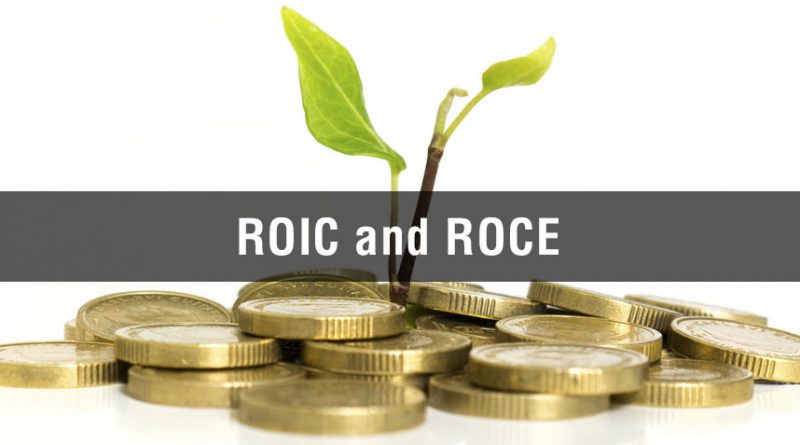Difference between ROIC and ROCE
Fundamental analysis is a popular technique to narrow down on stocks for investment. Fundamental analysis focuses on the level of the financial health of companies and seeks to determine if the companies are fundamentally strong. It involves calculating and analyzing various financial ratios like Price-to-Earnings ratio, Return on Capital Employed (ROCE), Debt to Equity ratio, Return on Invested Capital (ROIC) and more. These financial ratios can give an idea to the investor on whether the company is financially sound and stable.
Let us focus our attention on two specific ratios: Return on Capital Employed (ROCE) and Return on Invested Capital (ROIC). Both the ratios come under the category of profitability ratios and can provide the investors with a good idea about the financial soundness of different companies. Although both the ratios mentioned above might sound similar in meaning they represent various aspects of the financial picture of a company. This article discusses both these ratios in detail and the differences between the two.
What is Return on Capital Employed (ROCE)?
Return on Capital Employed (ROCE) is a financial ratio that helps the investors determine how efficiently a company uses its capital employed to generate Revenue. The numerator consists of Earnings Before Interest and Tax (EBIT) and Capital Employed gives the denominator. EBIT is Gross revenue before subtracting Interest on loans and taxes. Capital Employed is the sum of shareholder’s equity and long-term liabilities.
A higher ratio implies that the Earnings in relation to the capital employed are higher, thus signifying to the investor that the company has successfully utilized its capital employed to generate a good amount of profits. The company is capable of efficiently using its capital resources in order to produce high returns. Therefore, such a company would make an attractive investment destination for traders/investors.
You can calculate Return on Capital Employed by using the following formula.
Return on Capital Employed = Earnings before Interest and tax/ Capital Employed
Where,
Capital employed is the sum of shareholders’ equity and long-term debt liabilities or Total Assets Less Current Liabilities.
And EBIT is equal to Revenue before subtracting Interest and Tax
What is Return on Invested Capital (ROIC)?
Return on Invested Capital is another financial ratio that measures the company’s return by investing a said amount of capital. It allows the investors to estimate the return they can expect to achieve after investing in this company. As was the case with ROCE, a higher ROIC is also a positive indication with respect to the financial fundamentals of a company. A higher ROIC ratio implies that the company can efficiently generate earnings using the funds invested by the investors.
Following is the formula to help you calculate the ROIC ratio
Return on Invested Capital = Net Profit After Tax / Invested Capital
Where,
The sum of Fixed assets gives invested capital, intangible assets and current assets less the sum of current liabilities and cash. Net Profit After tax is Gross Profit minus taxes.
What is the difference between ROCE and ROIC?
Investors use both ratios to extract profitable companies from a pool of shares available in the market. Both ratios inform the investor how the company utilizes the money invested in the business to generate earnings. Investors get a fair idea of how much they can expect to earn in the form of dividends and capital gain after they invest in a company. The ratios also tell the investors whether the company has the ability to generate additional revenue in the future. However, despite these similarities, ROCE and ROIC are pretty distinct in their analysis.
While ROIC is based on invested capital, ROCE is based on capital employed which is a broader term than invested capital. Capital Employed for ROCE includes all the capital that the company employs in the business which is shareholder’s equity, long term debt obligations like loans and borrowings, as well as capital used for other activities except revenue generation. Invested capital under ROIC on the other hand, only includes capital used for the production of goods and services. Thus it is the sum of fixed and intangible assets of the company.
The scope of ROCE is vast since it considers capital employed which is more extensive than invested capital used for ROIC. ROIC is more refined as it only focuses on the capital circulated for the production of goods and services to generate revenue for the business.
Another primary difference between the figures is that while ROCE utilizes Earnings before Interest and taxes, ROIC considers net Profit, Revenue minus Interest and tax. Thus, ROCE is more relevant and helpful for the company. The company can look at the ROCE ratio to determine whether it can generate considerable profits with the capital invested in the company. ROIC is more relevant to the investors since it tells the investors how much they will be able to receive as dividends once the Interest and taxes are cut from the company’s gross revenue. In addition, ROIC is more beneficial for comparing companies with similar tax regimes to make easy inferences. ROCE is more suitable to compare companies among different industries and those under different tax regimes.
If the ROCE of a company is higher, it implies that the company’s management has the ability to manage the capital employed to generate increased revenues efficiently. In the case of a high ROIC, we can say that the company’s productivity of operating assets is good due to which we can see high net profits.
We can conclude that a company is profitable and utilizes its capital efficiently if the ROCE is greater than the cost of capital. For ROIC, if the ratio is greater than zero, we can say that the company is profitable. If ROIC turns out to be negative and ROCE is lower than the cost of capital, that means that the company has not invested and utilized its capital appropriately.
Conclusion
Making investment decisions requires a lot of time and effort from the investors. One of the main methods of making investment strategies is to conduct fundamental analysis on companies. Under fundamental analysis, there are two important ratios that the investor should study: ROIC and ROCE that show a company’s profitability. After reviewing the two ratios, the investor can grasp the company’s profitability, management ability, and future earnings prospects. The investor can use these ratios among different companies to find ventures with the best return potential.
Trustline is one of the best stock brokerage firms in India. As a reputed financial services company, Trustline allows customers to start trading with the facilities of all major Stock/ Commodity/ Currency exchanges for corporates, institutions & retail investors.




